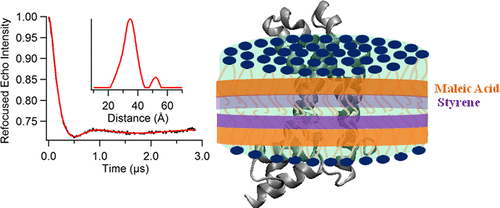当前位置:
X-MOL 学术
›
J. Phys. Chem. B
›
论文详情
Our official English website, www.x-mol.net, welcomes your
feedback! (Note: you will need to create a separate account there.)
Characterization of the Human KCNQ1 Voltage Sensing Domain (VSD) in Lipodisq Nanoparticles for Electron Paramagnetic Resonance (EPR) Spectroscopic Studies of Membrane Proteins.
The Journal of Physical Chemistry B ( IF 2.8 ) Pub Date : 2020-03-16 , DOI: 10.1021/acs.jpcb.9b11506 Indra D Sahu 1, 2 , Gunjan Dixit 1 , Warren D Reynolds 1 , Ryan Kaplevatsky 1 , Benjamin D Harding 1 , Colleen K Jaycox 1 , Robert M McCarrick 1 , Gary A Lorigan 1
The Journal of Physical Chemistry B ( IF 2.8 ) Pub Date : 2020-03-16 , DOI: 10.1021/acs.jpcb.9b11506 Indra D Sahu 1, 2 , Gunjan Dixit 1 , Warren D Reynolds 1 , Ryan Kaplevatsky 1 , Benjamin D Harding 1 , Colleen K Jaycox 1 , Robert M McCarrick 1 , Gary A Lorigan 1
Affiliation

|
Membrane proteins are responsible for conducting essential biological functions that are necessary for the survival of living organisms. In spite of their physiological importance, limited structural information is currently available as a result of challenges in applying biophysical techniques for studying these protein systems. Electron paramagnetic resonance (EPR) spectroscopy is a very powerful technique to study the structural and dynamic properties of membrane proteins. However, the application of EPR spectroscopy to membrane proteins in a native membrane-bound state is extremely challenging due to the complexity observed in inhomogeneity sample preparation and the dynamic motion of the spin label. Detergent micelles are very popular membrane mimetics for membrane proteins due to their smaller size and homogeneity, providing high-resolution structure analysis by solution NMR spectroscopy. However, it is important to test whether the protein structure in a micelle environment is the same as that of its membrane-bound state. Lipodisq nanoparticles or styrene-maleic acid copolymer-lipid nanoparticles (SMALPs) have been introduced as a potentially good membrane-mimetic system for structural studies of membrane proteins. Recently, we reported on the EPR characterization of the KCNE1 membrane protein having a single transmembrane incorporated into lipodisq nanoparticles. In this work, lipodisq nanoparticles were used as a membrane mimic system for probing the structural and dynamic properties of the more complicated membrane protein system human KCNQ1 voltage sensing domain (Q1-VSD) having four transmembrane helices using site-directed spin-labeling EPR spectroscopy. Characterization of spin-labeled Q1-VSD incorporated into lipodisq nanoparticles was carried out using CW-EPR spectral line shape analysis and pulsed EPR double-electron electron resonance (DEER) measurements. The CW-EPR spectra indicate an increase in spectral line broadening with the addition of the styrene-maleic acid (SMA) polymer which approaches close to the rigid limit providing a homogeneous stabilization of the protein-lipid complex. Similarly, EPR DEER measurements indicated a superior quality of distance measurement with an increase in the phase memory time (Tm) values upon incorporation of the sample into lipodisq nanoparticles when compared to proteoliposomes. These results are consistent with the solution NMR structural studies on the Q1-VSD. This study will be beneficial for researchers working on investigating the structural and dynamic properties of more complicated membrane protein systems using lipodisq nanoparticles.
中文翻译:

用于膜蛋白电子顺磁共振 (EPR) 光谱研究的 Lipodisq 纳米颗粒中人类 KCNQ1 电压传感域 (VSD) 的表征。
膜蛋白负责执行生物体生存所必需的基本生物学功能。尽管它们具有生理重要性,但由于在应用生物物理技术研究这些蛋白质系统方面存在挑战,目前可获得的结构信息有限。电子顺磁共振 (EPR) 光谱是研究膜蛋白结构和动态特性的一种非常强大的技术。然而,由于在不均匀样品制备中观察到的复杂性和自旋标签的动态运动,将 EPR 光谱应用于天然膜结合状态的膜蛋白极具挑战性。洗涤剂胶束由于其较小的尺寸和同质性,是非常流行的膜蛋白模拟物,通过溶液核磁共振光谱提供高分辨率结构分析。然而,重要的是测试胶束环境中的蛋白质结构是否与其膜结合状态相同。Lipodisq 纳米粒子或苯乙烯-马来酸共聚物-脂质纳米粒子 (SMALP) 已被引入作为膜蛋白结构研究的潜在良好膜模拟系统。最近,我们报道了 KCNE1 膜蛋白的 EPR 表征,该膜蛋白具有结合到 lipodisq 纳米颗粒中的单个跨膜。在这项工作中,lipodisq 纳米粒子被用作膜模拟系统,用于使用定点自旋标记 EPR 光谱探测具有四个跨膜螺旋的更复杂的膜蛋白系统人 KCNQ1 电压传感域 (Q1-VSD) 的结构和动态特性。使用 CW-EPR 谱线形状分析和脉冲 EPR 双电子电子共振 (DEER) 测量对结合到 lipodisq 纳米粒子中的自旋标记的 Q1-VSD 进行表征。CW-EPR 光谱表明,随着苯乙烯-马来酸 (SMA) 聚合物的添加,光谱线展宽增加,该聚合物接近刚性极限,从而提供了蛋白质-脂质复合物的均匀稳定化。相似地,与蛋白脂质体相比,EPR DEER 测量表明,在将样品掺入 lipodisq 纳米颗粒后,相记忆时间 (Tm) 值增加了距离测量的质量。这些结果与 Q1-VSD 的溶液 NMR 结构研究一致。这项研究将有利于研究人员使用 lipodisq 纳米粒子研究更复杂的膜蛋白系统的结构和动态特性。
更新日期:2020-03-19
中文翻译:

用于膜蛋白电子顺磁共振 (EPR) 光谱研究的 Lipodisq 纳米颗粒中人类 KCNQ1 电压传感域 (VSD) 的表征。
膜蛋白负责执行生物体生存所必需的基本生物学功能。尽管它们具有生理重要性,但由于在应用生物物理技术研究这些蛋白质系统方面存在挑战,目前可获得的结构信息有限。电子顺磁共振 (EPR) 光谱是研究膜蛋白结构和动态特性的一种非常强大的技术。然而,由于在不均匀样品制备中观察到的复杂性和自旋标签的动态运动,将 EPR 光谱应用于天然膜结合状态的膜蛋白极具挑战性。洗涤剂胶束由于其较小的尺寸和同质性,是非常流行的膜蛋白模拟物,通过溶液核磁共振光谱提供高分辨率结构分析。然而,重要的是测试胶束环境中的蛋白质结构是否与其膜结合状态相同。Lipodisq 纳米粒子或苯乙烯-马来酸共聚物-脂质纳米粒子 (SMALP) 已被引入作为膜蛋白结构研究的潜在良好膜模拟系统。最近,我们报道了 KCNE1 膜蛋白的 EPR 表征,该膜蛋白具有结合到 lipodisq 纳米颗粒中的单个跨膜。在这项工作中,lipodisq 纳米粒子被用作膜模拟系统,用于使用定点自旋标记 EPR 光谱探测具有四个跨膜螺旋的更复杂的膜蛋白系统人 KCNQ1 电压传感域 (Q1-VSD) 的结构和动态特性。使用 CW-EPR 谱线形状分析和脉冲 EPR 双电子电子共振 (DEER) 测量对结合到 lipodisq 纳米粒子中的自旋标记的 Q1-VSD 进行表征。CW-EPR 光谱表明,随着苯乙烯-马来酸 (SMA) 聚合物的添加,光谱线展宽增加,该聚合物接近刚性极限,从而提供了蛋白质-脂质复合物的均匀稳定化。相似地,与蛋白脂质体相比,EPR DEER 测量表明,在将样品掺入 lipodisq 纳米颗粒后,相记忆时间 (Tm) 值增加了距离测量的质量。这些结果与 Q1-VSD 的溶液 NMR 结构研究一致。这项研究将有利于研究人员使用 lipodisq 纳米粒子研究更复杂的膜蛋白系统的结构和动态特性。











































 京公网安备 11010802027423号
京公网安备 11010802027423号